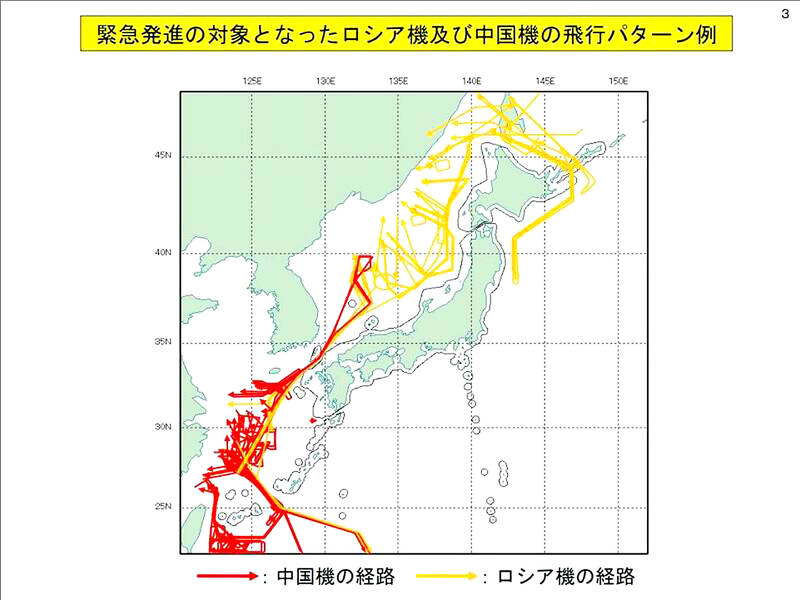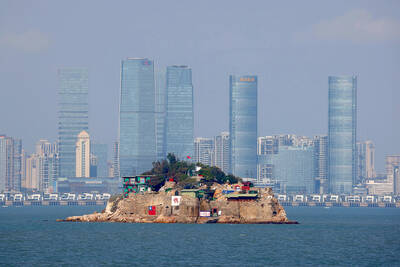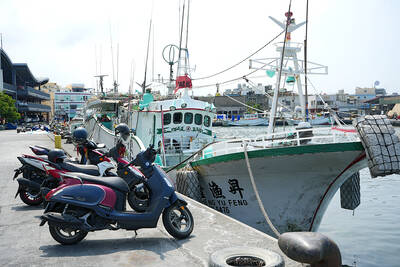Frequent harassment by Chinese and Russian warplanes has disturbed flight security in East Asia and destabilized geopolitics in the western Pacific region, the Japanese Ministry of Defense said.
From April to December last year, the Japan Air Self-defense Force scrambled fighter jets 555 times to intercept foreign military planes, mainly from China and Russia, the ministry said in a report.
Most of the intercepts occurred in Japan’s air defense identification zone (ADIZ) to the southwest.

Photo: Screen grab from a Japanese Ministry of Defense report
Of the 555 launches, 392, or 71 percent, were scrambled to intercept Chinese jets, and 148, or 24 percent, were to stop Russian jets.
The remaining 15 were made in response to aircraft from North Korea, Taiwan and other countries.
Japan’s southwestern ADIZ saw the majority of Chinese plane incursions at 327, or 58.9 percent, followed by the west at 97, the north at 94 and its central air space at 37, the report said.
The frequency of Chinese jet harassment near the Taiwan Strait and Japan’s southwestern ADIZ has decreased flight safety in the region, it said.
The Chinese warplanes included J-15 and J-16 jets, H-6 bombers, Y-9DZ electronic intelligence aircraft and BZK-005 uncrewed aerial vehicles, while Russian planes included Tu-95 bombers, IL-20 surveillance aircraft and IL-38 anti-submarine aircraft, the report said.
While the number of scrambled sorties dropped by 57 compared with the same period in 2022, reports from the US Naval Institute said that the region averages two scrambled launches a day and remains under high alert.
Two Russian-Chinese military exercises in the region involving long-range bombers, landing and take-off exercises on the Chinese People’s Liberation Army Navy Shandong carrier, and North Korean trial launches of intercontinental ballistic missiles are clear signals that Japan is facing severe external threats, the report added.

The Chinese Communist Party (CCP) is pushing for residents of Kinmen and Lienchiang counties to acquire Chinese ID cards in a bid to “blur national identities,” a source said. The efforts are part of China’s promotion of a “Kinmen-Xiamen twin-city living sphere, including a cross-strait integration pilot zone in China’s Fujian Province,” the source said. “The CCP is already treating residents of these outlying islands as Chinese citizens. It has also intensified its ‘united front’ efforts and infiltration of those islands,” the source said. “There is increasing evidence of espionage in Kinmen, particularly of Taiwanese military personnel being recruited by the

Left-Handed Girl (左撇子女孩), a film by Taiwanese director Tsou Shih-ching (鄒時擎) and cowritten by Oscar-winning director Sean Baker, won the Gan Foundation Award for Distribution at the Cannes Critics’ Week on Wednesday. The award, which includes a 20,000 euro (US$22,656) prize, is intended to support the French release of a first or second feature film by a new director. According to Critics’ Week, the prize would go to the film’s French distributor, Le Pacte. "A melodrama full of twists and turns, Left-Handed Girl retraces the daily life of a single mother and her two daughters in Taipei, combining the irresistible charm of

ENTERTAINERS IN CHINA: Taiwanese generally back the government being firm on infiltration and ‘united front’ work,’ the Asia-Pacific Elite Interchange Association said Most people support the government probing Taiwanese entertainers for allegedly “amplifying” the Chinese Communist Party’s propaganda, a survey conducted by the Asia-Pacific Elite Interchange Association showed on Friday. Public support stood at 56.4 percent for action by the Mainland Affairs Council and the Ministry of Culture to enhance scrutiny on Taiwanese performers and artists who have developed careers in China while allegedly adhering to the narrative of Beijing’s propaganda that denigrates or harms Taiwanese sovereignty, the poll showed. Thirty-three percent did not support the action, it showed. The poll showed that 51.5 percent of respondents supported the government’s investigation into Taiwanese who have

A Philippine official has denied allegations of mistreatment of crew members during Philippine authorities’ boarding of a Taiwanese fishing vessel on Monday. Philippine Bureau of Fisheries and Aquatic Resources (BFAR) spokesman Nazario Briguera on Friday said that BFAR law enforcement officers “observed the proper boarding protocols” when they boarded the Taiwanese vessel Sheng Yu Feng (昇漁豐號) and towed it to Basco Port in the Philippines. Briguera’s comments came a day after the Taiwanese captain of the Sheng Yu Feng, Chen Tsung-tun (陳宗頓), held a news conference in Pingtung County and accused the Philippine authorities of mistreatment during the boarding of